THE ROMAN & MEDIEVAL ERAS – TWO FACES OF VAISON LA ROMAINE
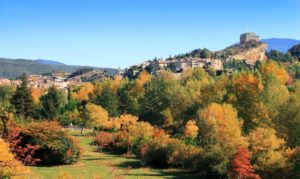
Provence is renowned for some of the most spectacular and extensive remains of the Roman empire. There are sites whose main claim to fame are the vast Roman arenas—most, if not all, still in regular use—monumental arches and temples dedicated to honour a variety of deities, including emperors themselves. We all know of the Pont du Gard and the spectacular arenas in Arles and Nimes, the theatre in Orange etc., and the many other great destinations in Provence that have impressive Roman remains. As though these weren’t enough, this region also has numerous towns and villages with outstanding examples of its medieval past. The picturesque town of Vaison la Romaine has both.
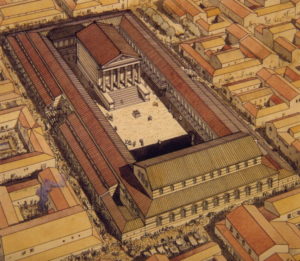
Vaison la Romaine is situated 30km N.E. of Orange, in the Vaucluse department of Provence. The town has a long and colourful history, stretching back before the Roman conquest over 2,000 years ago. It has been voted as one of the 100 best detours in France, and we can certainly agree with that!
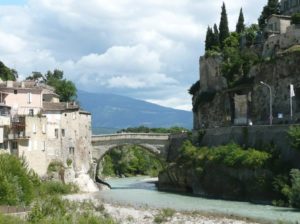
Vaison la Romaine has it all. Not only fascinating Roman ruins and a delightful medieval town centre, but a château high on a rock, arts festivals, wonderful vineyards and glorious countryside for hiking, biking or simply walking. The town is neatly split into two by the Ouveze River, with the medieval town on one side, snaking up the hill to the 12th century château, and the Gallo-Roman and the modern town on the other. They are joined together by what is claimed to be the oldest Roman bridge in France.
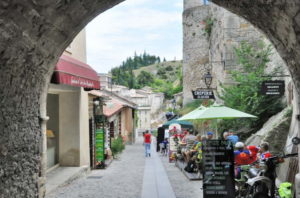
A leisurely stroll through the narrow, winding streets of the town is a delight, allowing you to admire the double fortifications, the belfry, the church, the ancient and richly ornate doorways, the squares adorned with cool fountains, and the houses built into the sides of the cliff.
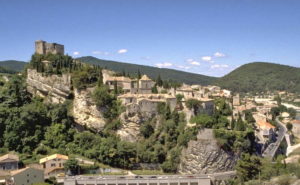
The ancient name of the town was Vasio, and was the capital of the Gallic tribe of the Vocontii, who built their town on the rocky outcrop near a sacred source dedicated to Vasio, the Goddess of Springs. The name ‘Vasio’ is interesting, as it’s neither Latin nor Celtic.
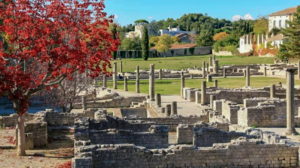
After the Roman conquest, the town was rebuilt on the west bank of the river around 20 BCE by Marcus Vipsanius Agrippa, the friend and son-in-law of the emperor Augustus.
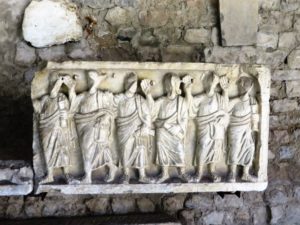
Just like Rome, Vaison la Romaine has 7 hills, and like Rome it had become very prosperous by the 1st century CE–it’s thought that its population in the 2nd century CE was about the same as it is today. By this time, the town had at least 5 thermal baths, an aqueduct, a basilica, a sanctuary, a bridge, a theatre and a portico. The streets, many lined with shops, were paved with limestone slabs from a nearby quarry, and it’s known that at least one side of the streets were covered by the overhang of the first floors of the buildings, designed to shelter pedestrians during bad weather.
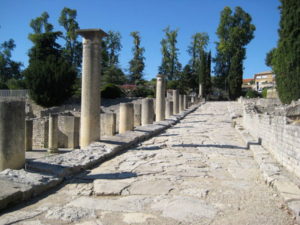
The luxury and scale of urban housing of Vasio exceeded that of towns such as Arles, Orange and Nimes, making it one of the most remarkable towns in ancient Provence, despite its relatively small size. The source of Vasio’s wealth is as yet still unknown, although the local Vocontii tribe sided with the Romans, who made Vasio a federated city and not a colony. This status probably had a positive impact on the development of trade. The two main Roman-era sites are Puymin and La Villasse, both of which are in the town centre, on each side of the Tourist Office. Pop in and grab a map of the town’s sites before you set out.
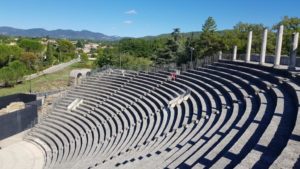
The amphitheatre of Vasio nestled into a hillside in the Puymin district of the town, dates from the 1st century. Several emperors had statues erected here, including Claudius, Domitian and Hadrian. Several paths lead to the amphitheatre. The stage wall was 25m high facing its 32 tiers of seats, constructed in a semi-circle, that could accommodate 7,000 spectators.
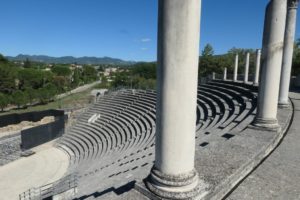
Today, the amphitheatre is used all year round for outdoor events such as concerts, conferences and theatre, and especially a prestigious International Festival of Dance in July and a Blues & Jazz Festival in August.
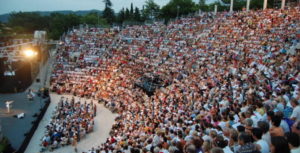
As well, every 3 years since 1953 Les Choralies de Vaison la Romaine, devoted to choirs comprising more than 5,000 choristers from all over the world come together to sing, take part in choral music workshops and give free concerts in the theatre. The last Choralies was August 2022, when more than 10,000 singers—professional and trained amateurs, plus choir directors, instrumentalists and others participated in the event!
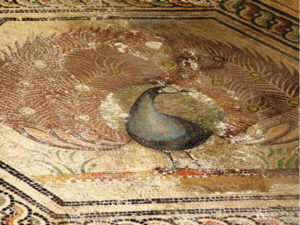
At the Puymin site you also stroll through the heart of the wealthy quarter of the ancient town. You can see the vestiges of beautiful patrician houses such as the 2000 sq.m. “House of the Wreathed Apollo”, and the 3000 sq.m. “Maison à la Tonnelle” (The Arbor House), thought to be a sanctuary with porticos framing a garden, a central building, a place for promenades and perhaps worship. Another of the more interesting mansions is the Villa du Paon (“House of the Peacock”), which has a splendid mosaic with a surface area of 33 sq.m.
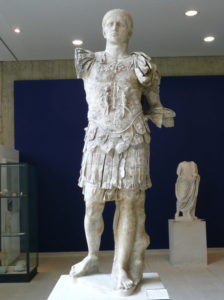
In the centre of the Puymin site you’ll find the Théo Desplans Archaeological Museum. It houses a large collection of local finds, around 2,000 items, such as pottery, mosaics, murals, objects from everyday life, and antique statuary. It’s set out to display ancient practices and way of life ranging from pre-historic to the Gallo-Roman era. The museum is also a major conservation and documents centre. As you visit the site, you’ll also see an alignment of sepulchres. In the 5th century CE, following a policy of rejecting everything that was pagan, the locals used part of the theatre’s foundations as sarcophagi.
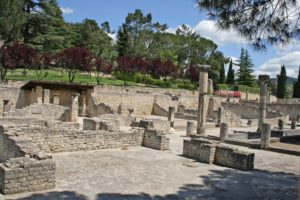
The La Villasse section of town occupies what had been the most affluent neighbourhood, full of prestigious shops and lifestyle, indicated by such names as Street of the Boutiques, the baths and fountains, sumptuous villas such as the “Maison du Dauphin” (House of the Dolphin), which had been a farm, the “Maison au Buste d’Argent” (House of the Silver Bust) and House of the Wreathed Apollo. These houses were beautifully decorated. Typically, they had fountains, light wells, interior peristyle gardens, exquisite rugs, wall hangings, artworks and fine quality furniture.
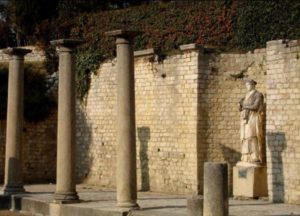
Certain practical rules of construction were followed such as kitchens to the north so food could be better preserved; bedrooms small so as to maintain their temperature better; the baths by an entrance so firewood did not have to be carried indoors too far. Heating was channelled around the house from the baths area, and windows were filled in with glass. In winter, sliding doors covered the entranceways, and there is still visible evidence of grooves for these at the Maison du Dauphin.
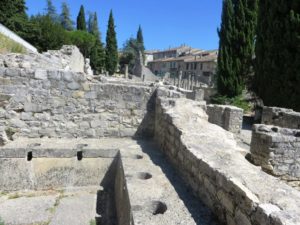
It was only in 1907 that a local cleric, Abbot Joseph Sautel, started to investigate the visible evidence of the town’s illustrious past, ending up spending the rest of his life excavating the Roman remains right in the centre of town. He was so successful, that in 1924 the town, up until then known simply as Vaison, appended “la Romaine” to its name. As well as the important Roman sites, Sautel’s original excavations brought to light artefacts from the late Neolithic age, and vestiges of habitat and ramparts from the Iron Age on the left bank of the river, at the foot of the Haute Ville.
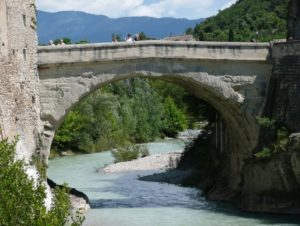
A bridge across the river was originally erected in 149 BCE, and the one today is said to be the oldest surviving Roman bridge. Many archaeologists regard it as one of the oldest still extant stone bridges in the world. Small, but perfectly formed, the 1st century Roman bridge is special since it is the only one outside Rome with an elliptical vault. In linking the Haute Ville to the lower town, the bridge turned Vaison la Romaine into an active river port from the Roman era and throughout the Middle Ages.
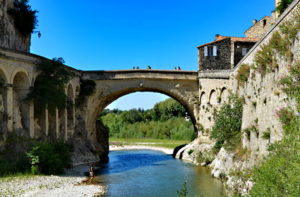
In constant use for over 2,000 years, it was classified as an historic monument in 1840. A testament to the quality of Roman civil engineering, the bridge has survived several tragic floods, including a major one in 1992, the worst since 1632, when 47 people were known to have died and 34 disappeared without trace.

The bridge doesn’t just take you over the river Ouvèze, it takes you from modern-day Vaison la Romaine and its the Roman ruins, to the Haute Ville, medieval quarter, perched on the rocky outcrop of the left bank. The medieval town was rebuilt and enlarged over the centuries, re-using or integrating vestiges of the past. The modern town we see today developed mainly from the mid 19th century onward, stretching over the ruins of the Romain city.
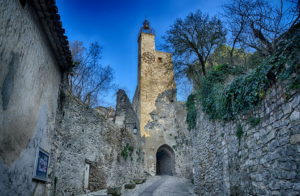
The barbarian invasions of the 5th century CE precipitated the fall of the Roman Empire and ruined this flourishing town, although it had already survived numerous incursions by raiding barbarians. This fall led naturally to the decline of paganism and the emergence of Christianity, although the town had already become a bishopric in the 4th century. The town became part of Provence around 545.
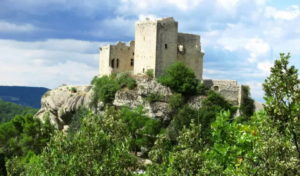
By the 12th century, disputes regularly broke out between the Counts of Provence—dependents of the Counts of Toulouse—who had re-fortified the ancient Haute Ville (upper town) and the bishops who ruled over the Basse Ville (lower town). These violent and destructive disputes had a terrible impact on the prosperity of the town, and only ended when a treaty was negotiated in 1251 by the future Pope, Clement IV, a native of Saint-Gilles-du-Gard, a commune in Provence.
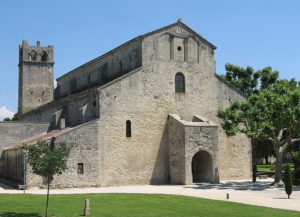
On the right bank of the river, in the Ville Basse, an Abbey was built in the Romanesque style between 6th and 13th centuries, the Cathedrale Notre-Dame de Nazareth (the mother church of the diocese of Vaison), and an episcopal palace. Today, you can visit the church and its lovely cloister, which has a small garden, arches and columns with some fine stone carvings. The Chapel of St Quentin a few streets further into the town is another Romanesque church, built in the 12th century. It’s classified as an Historic Monument, thanks to its murals, decorative friezes and Corinthian columns.
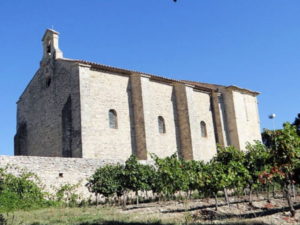
The population deserted the Ville Basse in the 13th century for the relative safety of the Haute Ville, which expanded throughout the Middle Ages. The first settlements reappeared on the right bank during the 17th century, but urbanisation only took off in the mid 19th century due to the lack of building space in the Haute Ville.
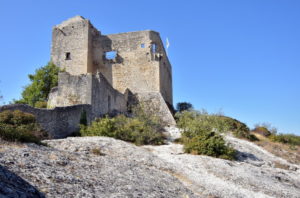
The Haute Ville developed around the château constructed by the Counts of Toulouse, known as Château Comtal, perched on a high rocky outcrop, which still boasts exceptional views of the lower town and surrounding landscape. The medieval town spread over 3 hectares, the fortifications were strengthened again in the 15th century, and a drawbridge and portcullis installed for access and additional security.
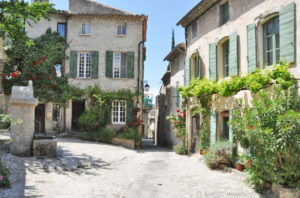
Most of the houses were built using stone taken from the Roman remains over on the right bank in the Ville Basse, and used to construct the steep lanes that lead up to the château and its courtyard, the small squares and their fountains. The central square is Place d’Orme, where you’ll find the Chapelle St Constance.
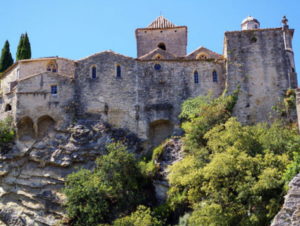
The lanes also lead to the Cathedrale Sainte-Marie de l’Assomption (or Cathedrale Haute) built in the 15th century, and regularly modified until the 18th century—it was classified as an historic monument in 1994. This cathedral replaced the 12th century church which had become too small to accommodate the population that flocked to the town from the 13th century. Not only does it flank the cliff, but its base forms part of the ramparts. This church later became a parish church, and in 2015 restoration work repaired the Jesuit style façade, medieval decorations and tower. This former church now serves as a venue for cultural events.
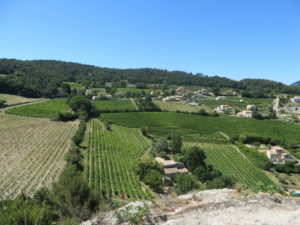
Vaison la Romaine has much to offer the visitor, in addition to all the Roman sites and the medieval village. There are plenty of nice little gift shops and pretty cafes to while away some time. Vineyards fill the land and flourish on the hillsides that lead up to Mont Ventoux—the wine produced belongs to AOC Cotes du Rhone and AOC Cotes du Ventoux. These full-bodied wines form the bulk of the wine produced, using Grenache, Syrah and Mourvèdre grapes. Rose is also produced locally. The area is filled with small producers rather than a major Domaine, so there are a couple of co-operatives that blend the grapes to produce the annual vintage.
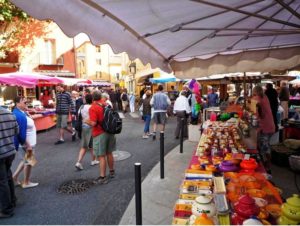
Since 1483, the town has hosted a thriving market. Today, it’s huge and takes over the whole town with around 450 stall-holders, held on Tuesdays (plus Thursday and Saturday in summer), which reflects the amount of produce that can be grown in the surrounding area. Truffles, fruits, herbs and honey are produced in abundance. A brocantes (flea) market is held on the 3rd Sunday of the month in Place Montfort. As well as the festivals already mentioned, there’s the Rencontres Gourmandes, a food festival held at the end of October.

There are plenty of walking trails in the wooded hillsides of Mont Ventoux, and those keen cyclists who follow the Tour de France may wish to test themselves up this infamous mountain—ask the tourist office for maps for a variety of trails and cycling routes. For the rest of us, exploring this fascinating small town and its rich history stretching over 2,000 years, is reward enough!
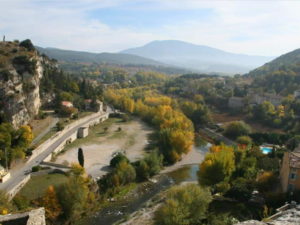


Fascinating as always.
Hi Nadine,
Pleased you enjoyed it. It’s a town we’ve been to a couple of times and there’s always something each visit that we come across or hadn’t noticed before–plus the great attraction of its having been a Roman town…!
Cheers, Cheryl